Overview
JelphaBot is a desktop application to help NUS students manage tasks. JelphaBot allows students to track and manage tasks conveniently. Users enter commands in JelphaBot through a CLI. However, a GUI is implemented with JavaFX for a smoother user experience. It is written in Java, and has about 13 kLoC.
Summary of contributions
-
Major enhancement: added the ability for users to add reminders to certain tasks.
-
What it does: allows users to add or remove reminders to remind tasks that will due soon to increase users' efficiency, including:
-
Tasks that are uncompleted
-
Tasks that will due within a week
-
-
Justification: As our target users are students with a lot of commitments, students may miss out several commitments over time. Therefore, they will need to manage their tasks and schedule upcoming tasks accordingly. Therefore, we have decided to include a reminding feature in JelphaBot to address this need. I implemented jelphaBot’s ability to link tasks and reminders, and combined them to maximize users' efficiency in fulfilling their commitments. This adds significant feature to JelphaBot, as a task manager and a task reminder.
-
Highlights:
-
This feature introduces a new class,
Reminder, which plays the similar significance toTask. TheReminderclass is leveraged on the Object-Oriented paradigm that aTaskneeds to be reminded by aReminder, therefore they are closely relatable to each other. To successfully design such a class that transcends a wide range of components, a complete understanding and thorough analysis of the whole application is required. -
Challenging as it requires real time synchronization and integration between GUI and internal logic components. For instance, a user, when deletes a
Task, should observe the deletion of its correspondingReminderfrom the UI as well. -
This feature is implemented in a way that it undergoes the whole application’s main components' development, in front-end and back-end. It involves the
Ui,Logic,Model, andStorage, with over 3k lines of functional and test code.
-
-
Relevant pull requests: #88, #149, #167, #179, #207, #309, #346
-
-
Code contributed: View on Reposense
-
Minor enhancement: Increased code coverage from 58% to 62% through writing new tests and improved existing tests.
-
Other contributions:
-
Enhancement to existing features:
-
Updated the GUI color scheme: #222
-
-
Documentation:
-
Updated JelphaBot’s architecture diagram for Developer Guide.
-
Updated the
Storagecomponent’s sequence diagram for Developer Guide. -
Added Use Case 7 and 8 for Developer Guide.
-
Added screenshots and descriptions as visual aids for User Guide.
-
-
Community:
-
Contributed to forum discussions: requesting usage for third-party libraries (controlsfx) #81
-
Reported bugs and suggestions for another team in PE dry run: Reported 15 bugs
-
-
Contributions to the User Guide
Given below are sections I contributed to the User Guide. They showcase my ability to write documentation targeting end-users. |
Set Reminders (Dian Hao)
JelphaBot allows you to set reminders for tasks and manage your tasks comprehensively! You can view all your existing reminders from the reminders tab.
Viewing your reminders : remindertab
You can enter the remindertab command or its shortcuts :R or :r to manually switch to the reminder tab.
The reminder panel will then show all the reminders that you have set.
Format: remindertab
Shortcut: :R or :r
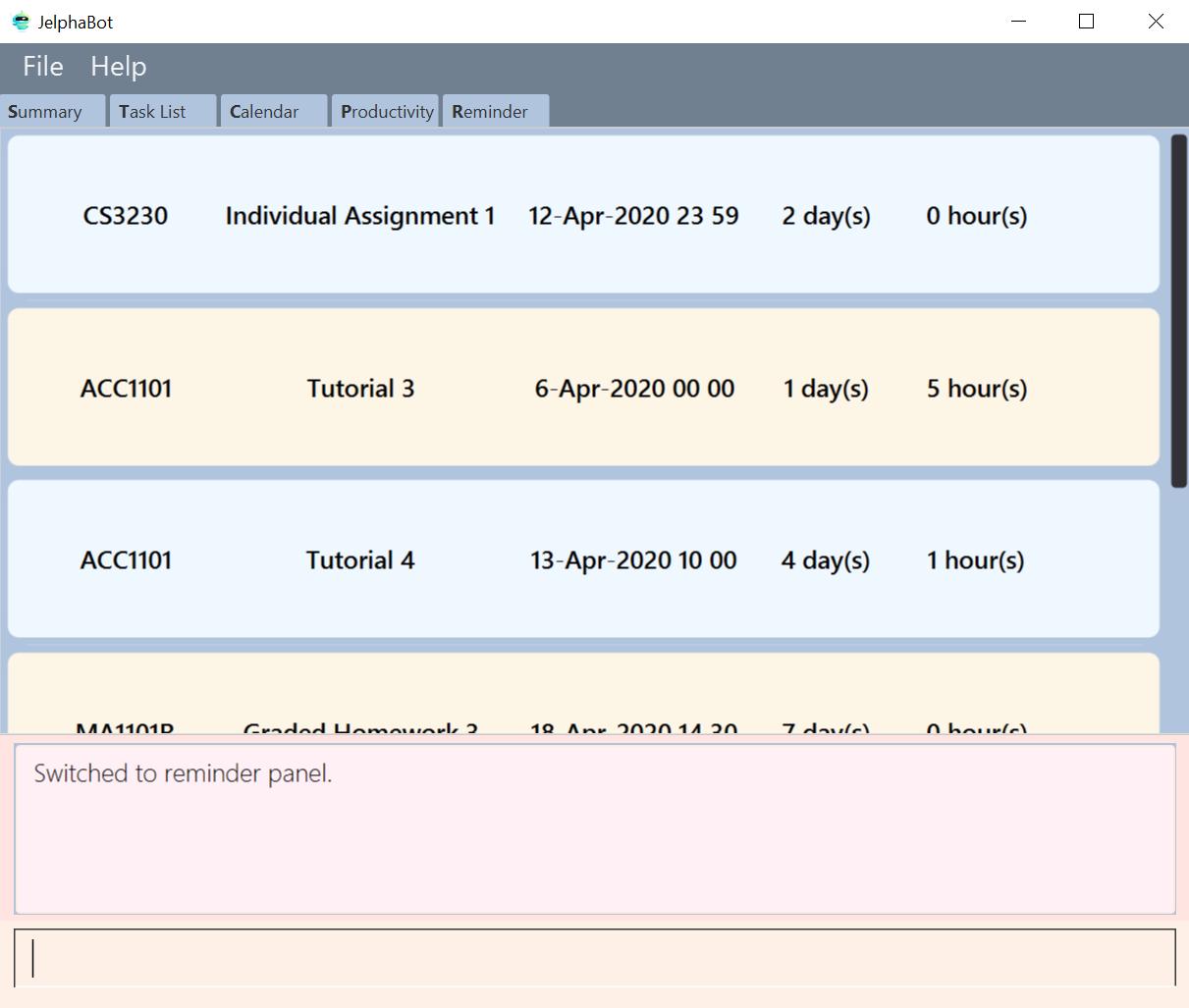
remindertabEvery Reminder will show the Task `s module code, description, due date, the days that will be reminded before the deadline, and the hours that will be reminded before the deadline.
Adding reminder : reminder
You can add a reminder to your specified task to remind yourself of the task if the current time is within the time-frame specified by you.
Format: reminder INDEX days/DAYS hours/HOURS
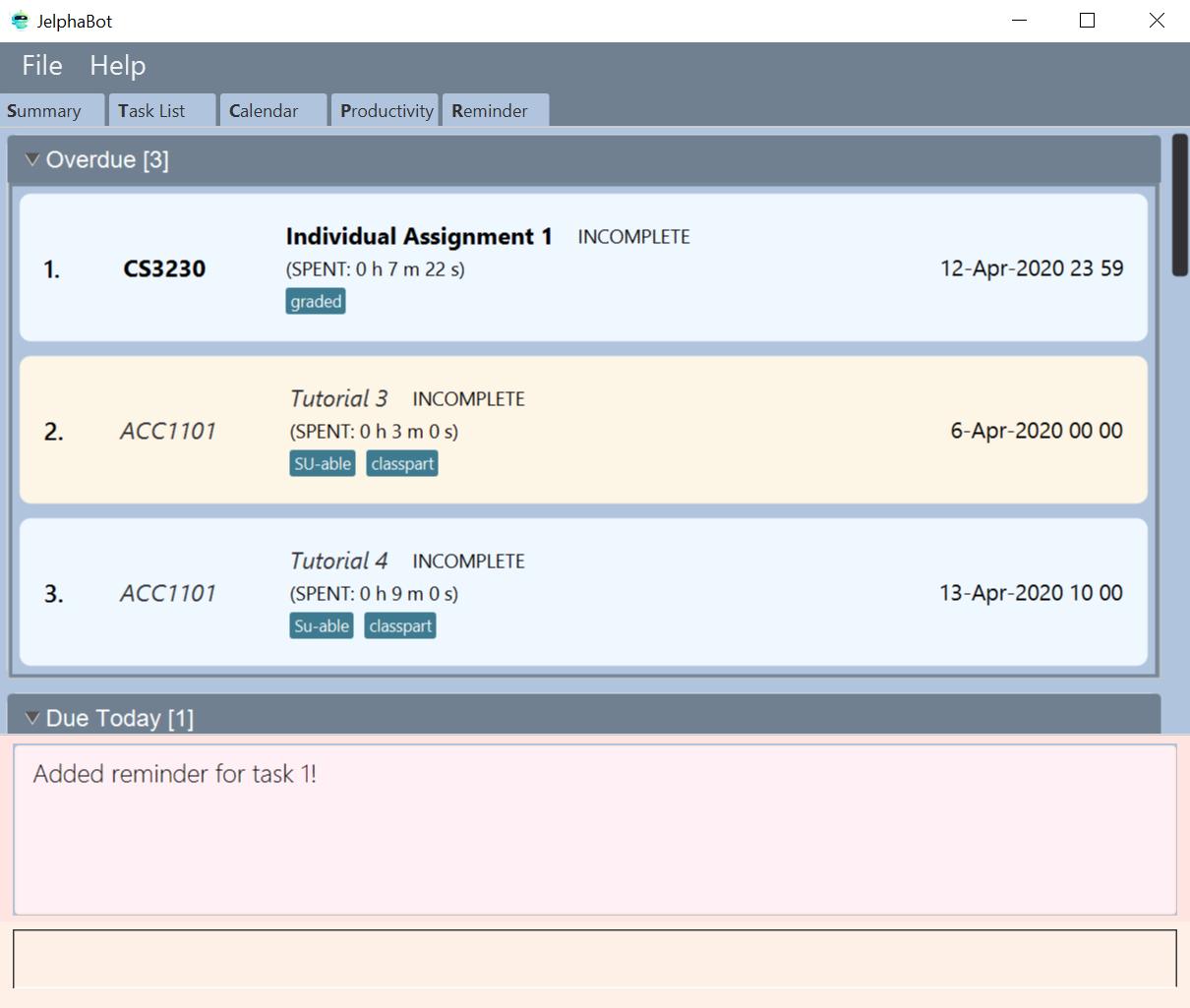
reminder 1 days/1 hours/1Removing reminder : delrem
If you would like for a task’s reminder to be deleted, you can use the delrem command to remove the reminder of that task.
Format: delrem INDEX

delrem 1Reminding you with a popup notification
Whenever you start up JelphaBot after adding your reminders, JelphaBot’s reminder window will popup. The popup will show a list of tasks that will be overdue soon, and tasks that are past their deadline but have not been completed.
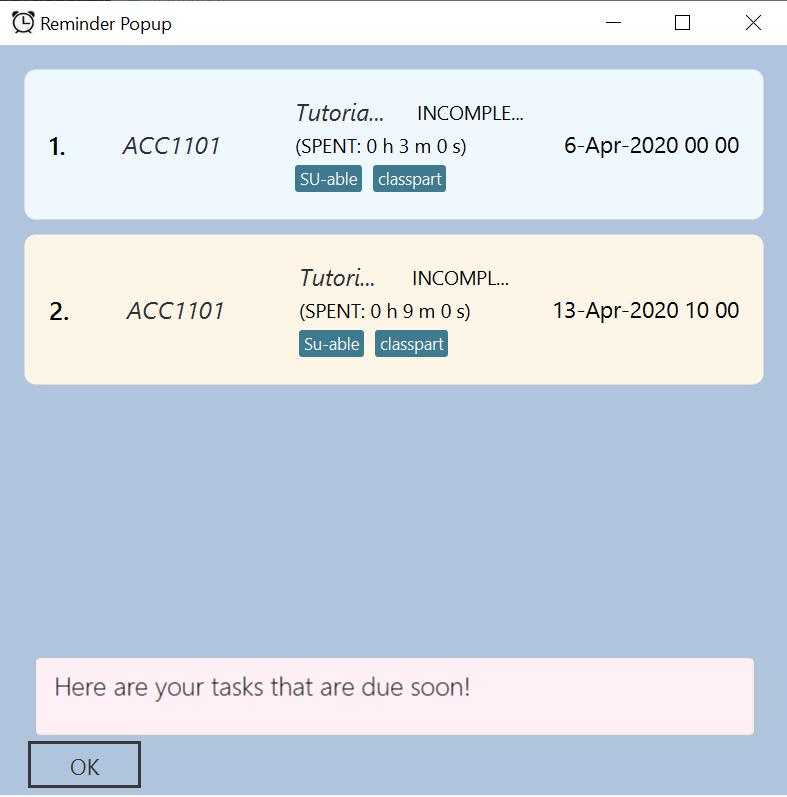
Contributions to the Developer Guide
Given below are sections I contributed to the Developer Guide. They showcase my ability to write technical documentation and the technical depth of my contributions to the project. |
Reminder feature (Dian Hao)
JelphaBot has a reminder feature that reminds users whenever they have tasks that will be overdue soon. This feature offers two main functions:
-
Adds a reminder to a task.
-
Delete a reminder that is associated to a task.
Classes for Reminder feature in Model
The Reminder feature was implemented by a new set of classes to Model.
A new Reminder class is stored in Jelphabot’s UniqueReminderList, which consists of a list of Reminder s.
Each Reminder consists of 3 objects:
Index: the Task 's index of which the user wants to be reminded for.
ReminderDay: the number of days before the Task 's deadline that the user wants to be reminded for.
ReminderHour: the number of hours before the Tasks 's deadline that the user wants to be reminded for.
The following class diagram summarizes shows the relationship between the classes.

Implementation
Function 1: Creates a reminder for a specified task
To add a reminder to a certain task, the user enters the reminder INDEX days/DAYS hours/HOURS command.
(e.g, reminder 2 days/2 hours/1)
The Logic execute() method creates a ReminderCommand from the input string by parsing the input according to the command word and several other attributes.
Next, the input string is converted into Index,
ReminderDay, ReminderHour, and a Reminder object with these properties are forwarded to Model.
The Model first checks the validity of the attributes respectively.
The valid Reminder is then added to the UniqueReminderList after checking that there are no other Reminder with the same Index.
After the above actions are correctly performed, the Logic fires the Storage to save the Reminder.
Upon successful execution of the command, the user adds a reminder associated to the task at INDEX.
Upon exiting JelphaBot, the reminder will be saved.
By the next time the users starts JelphaBot, it will remind the user should the task’s due date fall within the period set by the user from the current date.
The sequence diagram for interactions between the Logic, Model, and Storage is shown below.

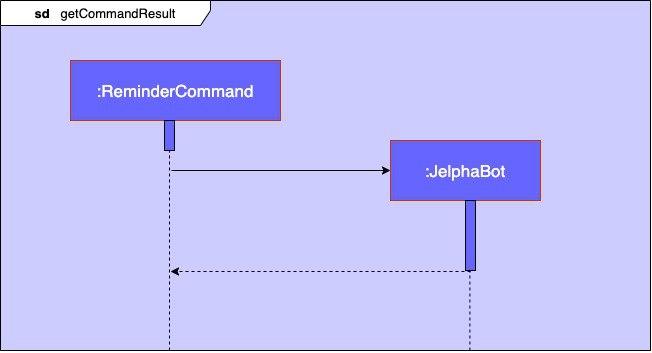
CommandResult in the Logic component.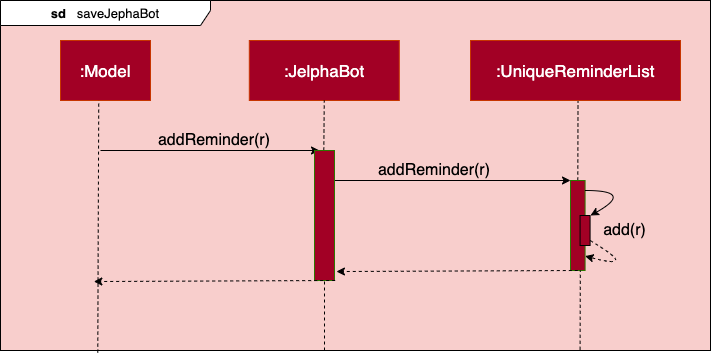
Reminder in the Model component.
Reminder by the Storage component.| If the user attempts to add a reminder to tasks that have reminders, the command will fail to execute. The user also will not need to set reminders to tasks that are complete. However, if tasks that has reminders are not completed, JelphaBot will still warn the user. |
Function 2: Deletes a reminder for a specified task
To delete a reminder associated to a certain task, the user enters the delrem INDEX command.
(e.g. delrem 2)
The interaction between components is similar to adding a Reminder.
A key difference that this command removes the Reminder that reminds the Task at INDEX from the UniqueReminderList.
Moreover, delrem command requires that the Reminder with INDEX is in the list.
Upon successful execution of the command, the reminder of the task at INDEX is removed.
Design Considerations
Aspect 1: Implementing Reminder object
-
Current solution: Implement
Reminderas a standalone class-
Rationale: A
Reminderis an object, with the same hierarchy as theTaskclass, with similar attributes. -
Pros: Fully capture the idea of an object-oriented design and robust in handling future changes.
-
Cons: An additional storage is required to store the
Reminderobjects, which causes overhead while reading from and writing to json files.
-
-
Alternative 1: Design
Reminderas one of the attributes of aTask-
Rationale: A
Remindercan also be seen as one ofTask's properties, analogous toDescriptionand other properties. -
Pros: Easy to implement. Concurrent fetching and storing from the json files while reading and writing
Task. -
Cons: A
Reminderhas to remind users the moment when Jelphabot is booted. At that instance,Storagehas not started to readTaskfrom the json files yet, therefore theRemindercould not be read beforehand.
-
Reason for chosen implementation:
We decided to choose the current solution due to the dynamic nature of tasks and users' needs.
For upcoming changes in the future, it is easier to implement by adding similar classes or attributes to the existing design.
Aspect 2: Rendering Reminder on ReminderListPanel
-
Current solution: Shows the
ModuleCode,Description, andDateTimeof theTaskthat is being reminded, the respectiveReminderDayandReminderHour.-
Pros: convenient and simple to understand. Users only need to refer to the
TaskListPanelto look at the details of theTask. -
Cons: FXML styling will be squeezy.
-
-
Alternative 1: Shows the
Remindersimilar to how theTaskis displayed.-
Pros: Simple, as it only shows the details of the
Reminder. -
Cons: Users need to constantly refer to the
TaskListPanelfor details. Both panels have anIndexlisted, which may cause confusion.
-
Reason for chosen implementation:
We decided to choose the current solution after considering users' needs and convenience of fully using the Reminder s.
Users do not need to switch back and forth between tabs to refer between Task s and Reminder s, which saves time that can be better spent by completing the Task s.